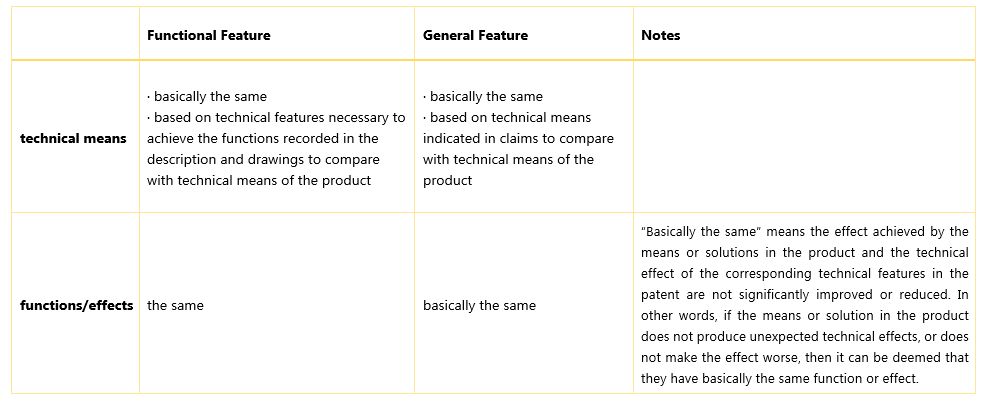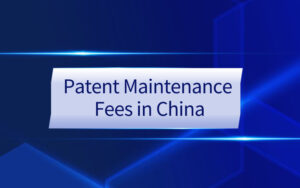Functional Feature & General Feature & Infringement Judgment
For “functional feature” of patents in China, the Guidelines for Patent Examination stipulates that “technical feature defined by function in a claim shall be construed as embracing all the means that are capable of performing the function”. From this definition, it seems that “functional feature” covers a broader protection extent than “general feature”. However, in actual cases of patent right protection, “functional features” may not be able to embrace the so-called all means. In this article, we will explain the infringement judgment of “functional features” in detail.

Functional Feature & Infringement Judgment
Article 8 in “Interpretation of the Supreme People’s Court on Issues Concerning the Application of Law in the Trial of Disputes over infringement of Patent Rights (II)” (hereinafter referred to as Interpretation II ) clearly stipulates “functional features” and their infringement comparison methods.
Article 8.1 stipulates that “ a functional feature refers to a technical feature in which the structures, compositions, steps, conditions or the relations therebetween are defined by their functions or effects achieved in the invention-creation, except that a specific embodiment for achieving the above functions or effects can be directly and specifically determined by those of ordinary skill in the art only by reading the claims.”
Generally speaking, “functional features” are features that define “what is achieved”. For example, a “fastening structure” does not define a specific structure, but is defined by realizing the effect of “fastening”.
Article 8.1 stipulates that “Where comparing with the technical feature that is necessary to achieve the functions or the effects mentioned in the preceding paragraph as recorded in the description and drawings, the corresponding technical feature of the accused infringing technical solution can adopt substantially the same means to perform the same functions and achieve the same effects, and can be contemplated by those of ordinary skill in the art without creative efforts upon occurrence of the accused infringing act, the courts shall find that said corresponding technical feature is identical or equivalent to the functional feature.”
It can be seen from above stipulations that when judging infringement of “functional features”, not only functions or effects but also technical means are compared. Because a claim does not disclose technical means, it is necessary to determine technical means that achieve the functions from the description and drawings. Meanwhile, it needs to compare with technical means of the product. If the technical means are substantially the same, it constitutes an infringement. However, if the product achieve the function or effect, but the description does not record substantially the same means to perform the same functions of products, it may not be considered an infringement.
Hence, as for “functional features”, whether constituting an infringement depends not only on the product having this function, but also on the technical means. The scope of protection of “functional features” is directly affected by the scope of technical means disclosed in the description.
General Feature & Infringement Judgment
Features other than “functional features” may be considered “general features”. That is, technical features that directly define the structures, components, steps, conditions or the relations therebetween of the invention can be regarded as “general features”. Generally speaking, “general features” are features that define “how to do”. For example, a “buckle” realizes the fastening between connectors, which is actually defined by the structure, not the effect.
Infringement judgments involving “general features” follow the principle of equivalent. Article 17 in Provisions of the Supreme People’s Court on Issues Concerning the Application of Law in the Trial of Disputes over infringement of Patent Rights stipulates infringement judgements of “general features” and equivalent features: “the extent of protection of the patent for invention or utility model shall be determined by the terms of the claims. The descriptions and attached diagrams may be used to interpret the claims” as mentioned in paragraph 1 of Article 59 of the Patent Law means that the extent of protection of the patent shall be determined by the extent determined by all technical features indicated in the claims, and shall also include the extent determined by the features that are equal to those technical features. Equivalent features mean the features that use similar means, realize similar functions and achieve similar effects as the technical features indicated in the claims, and that the ordinary technicians of the pertinent field may associate with these features without creative work when the alleged infringement occurs.” From above stipulations, it can be seen that “recorded technical features” of “equivalent features” mean “technical features indicated in the claims”. Therefore, when judging infringement of “general features”, it shall be based on the extent determined by all technical features indicated in the claims to determine whether the technical means of the product are basically the same.
Functional Feature VS General Feature

There is still uncertainty about actual judgment of “the same” and “basically the same” functions, so we can focus more on the differences in technical means. To put it simply, the technical means of “functional features” should be based on the description, while the technical means of “general features” should be based on to the claims. Therefore, “functional features” do not mean that technical means are not recorded, nor do they mean that technical means are not considered in infringement judgments, but that they need to be recorded in the description, and the infringement judgment should be based on the record in the description.
As for “functional features” “general features”, no one feature should be judged superior or inferior to another. Actually, they can be mutually complementary for filing patents. If technical means are various and very broad, and it is difficult to define them in the claims, “functional features” are undoubtedly more suitable to be included in the claims than “general features”. However, at this time we need to consider a question: how to ensure that the description covers enough technical means? One possible approach is to write more embodiments, but it is difficult to “write all of them” by “writing more”, and there will still be embodiments slipped between the cracks. In fact, when writing a patent, some general descriptions can be used to ensure that the coverage is wide enough, and at the same time, it will not cause the description to be too long.
How to Judge Infringement If Functional Features and General Features Coexist
According to Article 8.1 of the Interpretation II, technical features defined only by their functions or effects can be identified as “functional features”. Therefore, the definition method of “functional features + general features” cannot be identified as “functional features”, but it will be considered as “general features”, and the infringement judgment will be based on the standard of “general features”.
So, is the “functional feature” in this kind of definition method meaningless? The answer is a big NO. For example, when judging infringement, the effect of “general features” may be determined based on “functional features”. One thing to note is that describing this functional feature in the description has the same effect as that described in the claim. In this case, it can be considered that the “functional feature” in this definition method is a bit superfluous.
Here is a case about infringement judgement of “functional features + general features”.
- Case Background
A cleaning system company sued an auto parts Co., Ltd. for infringement of invention patents. The plaintiff won the case in the first instance; the defendant company appealed, and the judgment of the first instance was upheld in the second instance.
Although the judgment of the first instance and the second instance of this case was the same, the difference in the judgment of whether the technical feature is a “general feature” or a “functional feature” has an important guiding meaning.
Claim 1 of the patent involved in the case states that “in the closed position, the safety buckle extends facing the locking element to prevent the elastic deformation of the locking element and lock the connector”. Whether this feature is a “functional feature” or not, different conclusions were given in the first instance and the second instance. See below for details:
- In the First Instance
The court of first instance identified this feature as a “functional feature”, because those skilled in the art cannot directly and clearly determine the function of “preventing the elastic deformation of the locking element and locking the connector” only by reading the claim. Therefore, based on the record of the technical means in the description, it is believed that the technical means adopted by the defendant’s product and the patent involved in the case are basically the same, and both can achieve the technical effect of locking the connector. Thus, the defendant’s product is infringing the right.
- In the Second Instance
The defendant refused to accept the first-instance judgment, arguing that its technical means were not the same as those in the description.
However, in the second instance, the Supreme Court first denied the judgement that this feature is a “functional feature”. The court argued that “in the closed position, the safety buckle extends facing the locking element” in Claim 1 reflects the technical means of this function, which essentially belongs to a “general feature”. Based on this determination, and the comparison between the feature in the claim and the technical means in the product, it is believed that the two technical means are basically the same, and the effect achieved is also basically the same, so the defendant still infringes.
- Case Analysis
The guiding meaning of this case is that if “general features” and “functional features” coexist, they will be deemed as “general features”, and the infringement judgment will be made based on technical means indicated in claims. Therefore, it can also be seen from this case that the “functional features” in the definition method of “functional features + general features” are redundant.
Summarize
From the above case, it can be seen that there is a big difference in the infringement judgment between “general features” and “functional features”. Therefore, it is necessary to judge whether it is a “functional feature” first, and then it is reasonable to make an infringement judgment. Besides, thinking backwards when drafting a patent, is it really “a license to protect patents” if it is defined by “functional features”? The answer is not the case. If the description does not cover all aspects, the scope of protection may be greatly limited.

